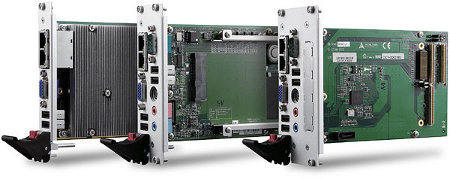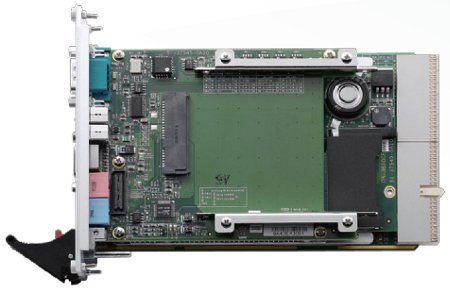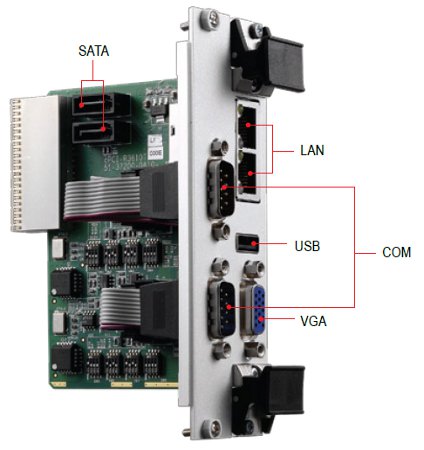CompactPCI boards adopt Pineview Atoms
Mar 10, 2010 — by Eric Brown — from the LinuxDevices Archive — 3 viewsAdlink is shipping a series of 3U CompactPCI processor blades with Intel Atom N450, D410, or dual-core D510 processors. The cPCI-3610 Series blades come in 4HP, 8HP, and 12HP versions, offer gigabit Ethernet, USB 2.0, and serial connectivity, and provide power consumption ranging from 15.2 to 19.35 Watts.
Adlink's 3U CompactPCI blades support Linux, Windows XP Professional, and VxWorks, and are aimed at mission-critical markets such as military, transportation, and automation, says the company. The cPCI-3610 Series offers various combinations of "Pineview" Atom processors, slot widths (HP), and I/O configurations, including two models that provide a rear transition module (RTM) for rear-facing I/O. In addition, Adlink says it can further mix and match configurations on request.

Adlink's 3U CompactPCI blades in 4HP, 8HP, and 12HP versions (left to right)
(Click to enlarge)
The Pineview processors integrate on-chip graphics, providing power savings compared to earlier Atom processors. Adlink says its blades use 15 Watts with the single-core CPUs (N450 or D410) and 19 Watts with the dual-core CPU (D510) at 100 percent loading. The N450-based blades can run fanlessly, and extended temperature versions of all the boards are available, says the company.

Adlink 3U CompactPCI
(Click to enlarge)

Port detail for the 4HP, 8HP, and 12HP versions (left to right)
(Click to enlarge)

The cPCI-R3610T model with rear transition module
(Click to enlarge)
- Processor — Intel Atom "Pineview" CPUs:
- N450 1.6GHz (cPCI-3610/N45, cPCI-3610D/N45, cPCI-3610P/N45)
- D410 1.66GHz (cPCI-3610D/D41)
- D510 1.66GHz (cPCI-3610D/D51)
- L2 cache — 512KB (N450) or 1MB (D410/2510)
- Chipset — Intel ICH8M I/O Controller Hub
- Memory — 1GB (expandable to 2GB) single-channel DDR2-667 SDRAM (soldered)
- Flash — 1 x CompactFlash socket onboard
- Storage — 1 x SATA direct connector for 2.5-inch onboard HDD (cPCI-3610D or cPCI-3610P); 2 x 7-pin SATA signal connectors on cPCI-R3610(T)
- Expansion (cPCI-3610P only) — optional 1 x PCI 32bit/66MHz PMC site or PCI-Express x1 XMC site
- Display — Up to QXGA (2048 x 1536) @75Hz, 32-bit on analog monitor; 1 x VGA port on faceplate; switchable to rear on cPCI-R3610(T)
- Networking — 2 x gigabit Ethernet (Intel 82574L) ports; front-facing, but switchable to rear on cPCI-R3610(T)
- Other I/O:
- USB — 2 x USB 2.0 ports (cPCI-3610); or 4 x USB 2.0 ports (cPCI-3610D or cPCI-3610P); 1 x additional RTM port on cPCI-R3610(T)
- Serial — 1 x RS-232/422/485/485+ selectable serial ports (cPCI-3610D or cPCI-3610P); 2 x additional serial ports on cPCI-R3610(T); none on cPCI-3610
- PS/2 — 1 x front-panel PS/2 port (cPCI-3610D or cPCI-3610P); none on cPCI-3610
- Audio — Line In and Line Out (cPCI-3610D or cPCI-3610P); none on cPCI-3610
- Other features — Power/WDT LEDs; coin Li-Ion battery; watchdog timer; hardware monitor
- Operating temperature — 32 to 158 deg. F (0 to 70 deg. C); ext. temp version -40 to 185 deg. F (-40 to 85 deg. C); fanless operation on N450 models
- Shock resistance — 15G peak-to-peak, 11ms duration, non-operating
- Vibration resistance — 1.88 Grms random vibration, 5-500Hz, each axis, operating
- Power consumption — 15.2 Watts for N450 (cPCI-3610/N45, cPCI-3610D/N45, cPCI-3610P/N45); 19.35 Watts for D510 (cPCI-3610D/D51)
- Dimensions/form factor:
- 3U CompactPCI; 3.94 x 6.30 inches (100 x 160mm)
- 4HP (cPCI-3610/N45)
- 8HP (cPCI-3610D/N45, cPCI-3610D/D51, cPCI-3610D/D41, cPCI-R3610, or cPCI-R3610T)
- 12HP (cPCI-3610P/N45)
- PCI 32-bit, 33MHz
- 3.3V or 5V universal V (I/O)
- PICMG 2.0 CompactPCI R3.0
- PICMG 2.1 Hot Swap R2.0
- Operating system — RedHat Enterprise Linux; Wind River Linux; VxWorks; Windows XP Professional
Stated Eric Kao, Senior Manager of Adlink's Modular Computing Product Center, "Adlink's cPCI-3610 Series CompactPCI processor blade with the Intel Atom processor D510 provides an optimal combination of dual-core performance, 3D-rich graphics features, extremely low overall power consumption and cost effectiveness."
Availability
The cPCI-3610 is available for a list price starting at $1,049 with processor and memory, says Adlink. More information may be found here.
This article was originally published on LinuxDevices.com and has been donated to the open source community by QuinStreet Inc. Please visit LinuxToday.com for up-to-date news and articles about Linux and open source.